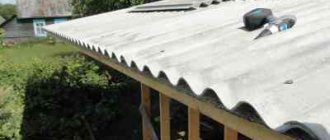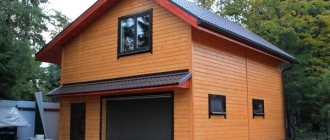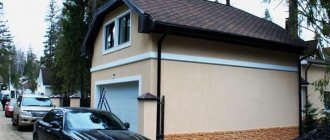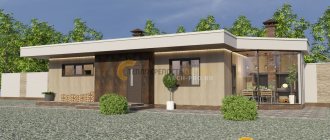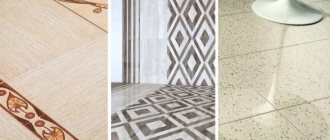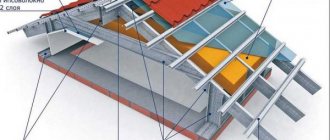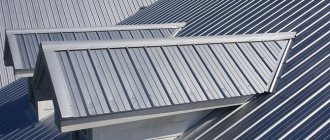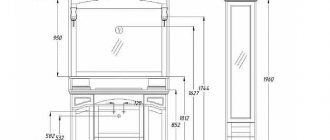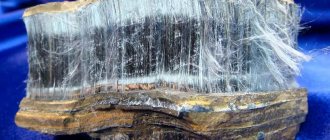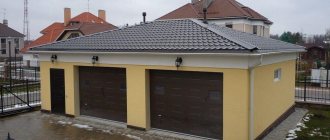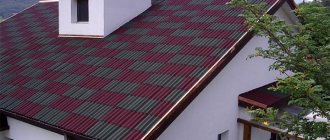Slate is a popular material that is inexpensive, but highly reliable and durable. If you paint it, then in terms of decorativeness it can easily compete with modern roofing materials. Therefore, the scope of application of slate is practically unlimited: asbestos-cement roofs can be found on both modest country houses and luxury cottages.
The spread of the material is also facilitated by the fact that laying slate on a roof is not a difficult job, anyone can do it. But in order for the coating to last, as it should, for at least half a century, you will need to study all the nuances of this simple but important event.
Technical characteristics of slate
Let's start with the fact that 20-25 years ago, companies that produced new roofing materials started an anti-slate campaign. They began to claim that this roofing building material contained asbestos, which causes cancer in people. All this is an outright lie, because the slate uses chrysolite asbestos - safe for humans, and not amphibole asbestos, which is harmful to us.
In addition, the substance itself is in a bound state in the product. So we can talk about its danger only if cutting is done using a grinder. In this process, dust will be released from under the cutting tool. She is harmful.
Types of slate according to technical characteristics Source ms.decorexpro.com
Now about the technical characteristics that the buyer must know about before purchasing it:
- There are 6, 7 or 8 wave slates on the market today.
- Sheet thickness: 5.8; 6.0 and 7.5 mm. Here the connection is direct with the wave height; the larger this size, the thicker the material.
- Depending on the number of waves present, the width of the sheets varies in the range of 98-113 cm.
- The bending strength of the sheet is 16 MPa. This is the lowest rate among modern roofing materials.
- Slate itself is fragile, and it does not withstand shock loads well.
- All manufacturers provide a guarantee of 40 years of operation. Experience has shown that slate roofing covers last much longer.
Seven-wave asbestos slate Source softwaremonster.info
A type of euro slate - sheets of homogeneous polymers
Slate tiles have been used to make slate since the Middle Ages. Such natural slate was mined from rocks under the name slate. Interestingly, the rock formation of this material is very interesting: the minerals are arranged in layers that are almost parallel to each other. Therefore, it was practically not difficult to extract slate from these rocks; it was possible to break off a piece with very little effort.
The composition of slate intended for roofing usually consists of clay shale. The shade of the finished material depends on the type of impurities that are added to the clay mass. Coal, brown iron ore and feldspar can be added to this mass.
Slate is usually mined by hand, which is why it costs much more than other materials. This material can be classified as “elite”, which not everyone can afford. Slates have always had an inherent shine, so this material also has value in the decorative field.
It is worth highlighting the main positive properties of slate made from natural slate:
- Good sound insulation. No matter how heavy the rain is, if slate slate is chosen as the roofing material, you will not hear its sounds inside your room.
- Resistant to temperature changes. In addition to the fact that slate does not lose its properties after many defrosting cycles, it will not be subject to deformation during extreme heat.
- Wear resistance. The density and strength of slate make it a truly reliable roofing material.
- Uniform and uniform structure.
- Low water absorption.
- Fire resistance. Slate slate is not subject to combustion and does not melt in a fire.
- Chemical and biological resistance to chemicals and bacteria.
- Long service life - more than 100 years.
- light weight;
- relatively low cost;
- high performance;
- high environmental friendliness;
- installation on surfaces with a bending radius of more than 5 m.
Roofing tiles made from slate have an average thickness of 5 mm. Their shape can be completely different: you can find tiles in the shape of a trapezoid, rectangle and triangle. Such slate tiles weigh from 28 to 35 kg per sq.m. The natural properties of slate and the use of various installation methods help to install roofs of any complexity. You can also cover the roof with a mosaic, laying out tiles of different colors one by one (more details: “Installation of slate roofing - installation methods”).
As you can see in the photo, in appearance Euroslate is practically no different from its “relative”; their compositions and, as a result, properties are very different.
Euroslate is a soft and deformable material (more details: “Euroslate - reviews and main characteristics”). It consists of materials such as cellulose fibers, polymer and fiberglass, bitumen or rubber compounds. Therefore, the Euro slate group usually includes fiberglass slate and fiberglass slate. This category also includes polymer sheets made by extrusion, that is, pressing the material through a molding hole.
Euroslate has some undeniable advantages:
This type of Euro slate includes acrylic sheets - completely transparent - and polycarbonate - translucent (more details: “Transparent PVC slate - application and installation”).
Since acrylic is colorless and transparent, it is also called plexiglass. This material is elastic and can take different shapes at high temperatures. It is also durable and can withstand considerable loads. The leaf itself contains small channels that can be filled with air. Since the product transmits ultraviolet radiation well and has excellent thermal insulation properties, it is successfully used in roofing solariums and swimming pools.
But polycarbonate is more common than acrylic. Its main advantages: non-flammability, resistance to chemical, impact and wind influences.
But the common advantage of all polymer materials remains plasticity. This property makes it possible to completely manufacture a wide variety of structures from them, regardless of the shape of their base. When constructing arches or vaults, you can use polymer materials without any load-bearing support.
Natural slate consists of tiles chipped from a block of natural stone, which is a type of slate. This material has been used since the Middle Ages. Shales are rocks characterized by an almost parallel arrangement of plate-like or elongated minerals that can be easily split with little effort.
Roofing material is made from clay shales, which are dark gray or black in color with various shades: reddish or greenish, depending on the type of inclusions. Impurities in the clay mass can be feldspar, coal, and brown iron ore. The inherent shine of slate tiles makes the appearance of roofs unique from a decorative point of view.
Slate can be painted, so you can choose it for any building facade.
When extracting and processing this material, manual labor is usually used, which is why slate slate is expensive and belongs to the elite category. Slate, being a natural stone, has a number of valuable operational advantages:
- good sound insulation; in rain and wind, noise is not transmitted to the interior;
- lack of response to frequent temperature changes and the ability not to deform when heated;
- density, strength, high resistance to wear and abrasion;
- uniformity of structure;
- low water absorption.
This material is fire-resistant, not susceptible to acids and biologically active environments. The service life of slate roofing material is more than 100 years.
Roofing tiles with a thickness of 4 - 6 mm can have a trapezoidal, rectangular or triangular shape.
A square meter of such a roof weighs 28–35 kg. Thanks to the variety of installation methods and the unique natural properties of slates, it is possible to make roofs of any configuration and complexity from this material, covering all its details: ridges, valleys, abutments. The rich color range of tiles makes it possible to design roofs with patterns and ornaments.
This group includes transparent acrylic and translucent polycarbonate.
Acrylic is elastic, has the ability to withstand significant loads, and can be deformed at elevated temperatures, which allows you to obtain the required shapes. Acrylic, like glass, is colorless; it has a second, more common name - plexiglass. Acrylic sheets with a special structure are used for roofing.
The sheet contains channels that are filled with air; they are separated from each other by stiffening ribs. Such materials, along with low weight, have structural strength and good thermal insulation properties. The warranty period is about 10 years. Acrylic perfectly transmits ultraviolet light. This property makes it possible to use the material for roofing solariums and swimming pools. However, for furniture, acrylic roofing does not protect against fading.
Polycarbonate is a more common material than acrylic. Roofing sheets made of polycarbonate have low flammability, chemical resistance, and resist wind loads and impacts.
One of the advantages of polymer materials is their high plasticity. This quality allows us to make from them not only individual elements, but also entire dome structures with different base configurations - square, round, rectangular. Polymer materials can be used in the construction of small vaults and arches, which does not require load-bearing structures, since the roof is self-supporting.
However, polymer materials have a number of properties that somewhat limit their scope of application. The fact that the coefficient of thermal expansion of polymers exceeds that of load-bearing structures requires careful calculations when designing structures, especially with a large roof area.
In modern domestic construction, there is a tendency to move from traditional asbestos-cement slate to its more advanced modifications, which do not contain substances harmful to the atmosphere and human health and allow the creation of attractive roofing structures.
Advantages and disadvantages
There is a large amount of information on the Internet regarding the advantages of this roofing material. Experts highlight two main ones: low price and good service life. The last advantage is possible only if the slate laying technology has been 100% maintained.
Now about the shortcomings, of which there were many:
- Many companies producing corrugated slate offer material with quite serious errors in shape and size. Therefore, the process of laying it on the roof becomes a big problem. The sheets must be adjusted to each other, swapped all the time, aligned and precisely joined.
- Heavy weight. Under the slate you will have to build a powerful rafter system, which will negate the savings in purchasing this roofing. Lifting sheets onto the roof is also difficult, and it is inconvenient for roofers to work while lifting them. Especially if one sheet has to be shifted, trimmed or shifted all the time.
- During operation, sheets may break. It’s good if the crack goes along the upper wave. This defect is not critical. But if a fracture occurs along the lower plane, then the sheet will have to be replaced or repaired. Again costs.
- You can lay corrugated sheets and bitumen shingles with your own hands. These are simple processes. But when the question is raised about how to properly cover a roof with slate, you cannot do without an experienced craftsman. You can try on your own, but the quality of the final result is not guaranteed. Moreover, not everyone can hammer a nail correctly so as not to break the sheets.
Powerful rafter structure for slate Source krovlyakryshi.ru
Roofing device
Slate roofs are mainly made of single or gable roofs. First, a rafter system is erected, then transverse sheathing bars are placed on it. Since the weight of the sheets is quite decent (a square meter weighs about 14-16 kg), you need to use bars with a medium section of 40*40 mm or 50*50 mm - depending on the thickness (and weight) of the sheets and the amount of snow falling in winter.
The simplest version of a slate pie
If the roof is cold (a very bad choice for a bathhouse), after installing the rafter system, you can immediately begin installing the sheathing. But it is highly desirable to use at least roofing felt for better thermal and waterproofing. It is laid across the joists and nailed down with nails or staples from a construction stapler.
When using sheets of standard profile (VO), a 50*50 mm bar is used for the sheathing, and a 75*75 mm bar for the reinforced one. The sheathing pitch is from 50 to 75 cm. It is chosen so that it is convenient to attach the sheets: each of them must have at least two crossbars.
All planks in the sheathing must be installed strictly horizontally. To do this, align the bottom strip exactly along the roof overhang. Then cut a piece of the block, the length of which is equal to the selected step. And with its help you verify all distances.
The sheathing strips are nailed to the rafters with long roofing nails. Two for each connection. The sheathing is made continuous around the pipe and in the valley.
You need to check the condition of the roof twice a year: before the start of the rainy season - in early autumn and after its end - in late spring.
It is necessary to clear away debris, plants and moss. It is mosses that need to be combated most actively: they secrete an acid-containing liquid that quickly destroys slate.
Over time, cracks appear on the roof
Sometimes the sheets crack or small holes form on them. They can be sealed with putty. You can prepare it yourself. You will need:
- 1 part of cement grade M-300;
- 3 parts asbestos fibers;
- PVA glue;
- water.
First, asbestos and cement are mixed dry. In a separate container, dilute PVA with water in a ratio of 1*1.
The area to be repaired is cleaned of dirt, washed with water, and then allowed to dry. Then coat with PVA diluted in water. After drying, an aqueous solution of PVA is gradually added to the mixture of cement and asbestos until a paste-like consistency is obtained.
This mass covers up the damage. The layer must be at least 2 mm. After the putty has dried, the repair area is painted over. It is better to work with PVA on a cloudy day - on a heated roof everything sets instantly, and you won’t have time to properly level it.
There are two more methods for sealing cracks. Using molten tar and using a fused roof. There are no questions about efficiency. If everything is done correctly, there will be no leaks. There are questions about the appearance: on a light gray roof, the black patches are very visible. Unless you glue a piece of slate on top, covering the size of the patch. In general, see the video for two more ways to repair slate.
Useful tips
Before moving directly to the topic of the article, namely, how to lay slate, I would like to give a few recommendations.
First, you should not paint slate after laying it on the roof. After applying the paint and varnish material, the coating will look good. But after a few days it will become covered with faded spots. It's all about the heterogeneous porosity of the material. In some places it will quickly absorb paint, in others slowly. Therefore, it is recommended to purchase painted slate, which is offered by manufacturers today.
Painting slate is useless Source remontik.org
See also: Catalog of companies that specialize in roofing materials.
There are two painting technologies: pigment is added to the raw material mass, so the color is obtained throughout the entire thickness of the sheets, or the paint is applied to the surface of the finished product. For this purpose, special paints and varnishes are used that are well absorbed and do not fade in the sun. The first option is better, but it is correspondingly more expensive.
The second is installation of the sheathing. The number of sheathing elements depends on the angle of inclination of the roof slopes. But experts adhere to the golden rule - the slate must lie on at least four slats. In addition, the entire roofing system must be stable. Therefore, before putting slate on the roof, it is recommended to walk on it and try to loosen it.
Slate lathing Source www.stroimdom.com.ua
Third, how to fasten the slate and how to do it correctly. There is information on the Internet that it is optimal to fasten with self-tapping screws, for which holes are made in the slate covering using a drill. This information is for those who do not understand anything about roofing. This technology will take a very long time. Plus, there is no guarantee that the sheets will be firmly held by self-tapping screws. In addition, you will have to place either sealing washers under them, or fill the holes with silicone sealant.
Craftsmen use slate nails all the time. This is a guarantee of high quality. Of course, hammering such a nail is not easy, but not for them. You can learn how to use nails quickly, although you will have to ruin more than one sheet. Therefore, my advice is to try it on damaged or used material. Twenty to thirty holes punched and you'll be driving nails in like a real roofer.
Slate steel nails Source hi.decorexpro.com
Fourth - how to properly lay slate on the roof. This refers to the arrangement of the sheets relative to each other. Like all roofing materials, slate is laid overlapping in one wave. To ensure that the joining point does not stand out from the total mass of laid material, manufacturers make the outer wave thinner. The product marking is applied to its upper surface. It is on this plane that the adjacent slate should lie, covering the inscription.
Attention! There is no need to hammer nails into the overlap area. The joint itself is strong.
The marking on the slate is covered with an adjacent sheet Source gid-str.ru
Stage 2. Calculation of roofing material
Before laying slate, you need to make some calculations. Correctly determining the amount of roofing material will allow you to avoid unnecessary costs associated with the additional purchase of missing sheets and corresponding transportation costs.
When performing calculations, you should remember that not the entire sheet area is useful; some part is lost under the overlap.
To correctly calculate the number of slate sheets, you can use this method:
- First, calculate the number of sheets in a horizontal row using the formula
Г = (Шс+2С)/(Шл-Шп), where
G - number of sheets,
Shs - width of the slope,
Sf is the length of the gable overhang,
Wl - sheet width,
Шп - width of the sheet under the overlap.
The number of sheets of a longitudinal row is determined in this way:
P = (D+Sk)/(Dl-Dn), where
P - number of sheets in vertical rows,
D is the length of the slope,
C is the length of the eaves slope,
L - leaf length,
DN is the length of the vertical overlap.
The resulting values of G and P are rounded to a whole number and multiplied. The result is the number of slate sheets for one roof slope with certain parameters.
Slate installation rules
Let's go further and go directly to the step-by-step instructions - how to properly lay slate on the roof:
- First, the rafter system is checked to ensure its correct assembly. That is, four sheathing slats must be laid under each asbestos sheet.
- A board is nailed to the ends of the rafter legs at the overhang. Some craftsmen use a tensioned thread, but a board is better; in this case, it will additionally work as a stop for heavy sheet material. After completion of the work, the board is dismantled.
- The slate of the first row is laid with emphasis on the hammered board. Make sure that the lower edges of the material fit tightly to the surface of the board.
- Each sheet is nailed. Usually the scheme is as follows - through two waves to the third. Therefore, the consumption of nails is 10 pieces per sheet. We have already discussed how to fasten slate with nails. Let us add that the blow with a hammer should be sharp.
- As for trimming the corners, they should be trimmed at the second and third sheets, while the first and fourth remain intact.
Slate laying scheme Source teplica-exp.ru
The foundation must be strong
The procedure for installing a slate roof is as follows: sheathing, laying slate, installing additional elements.
First, a durable sheathing is installed. It must support the weight of the slate and one or two people who will lay it. Coniferous wood is suitable for sheathing, as it is better resistant to rotting. Make sure that all elements of the sheathing are level and the joints do not protrude. Experts recommend using timber with a cross-section of 60X60 mm or boards for sheathing. Slate is strong enough and it is not necessary to make a continuous sheathing under it. Pay special attention to places where you always need to make a continuous sheathing: valleys, cornices, gutters. The vapor barrier coating takes place after installation of the sheathing. The final stage will be the installation of gutters.
How to lift slate sheets onto a roof
To do this, you will need two wooden slats with a cross section of 50x50 mm. Their length is selected experimentally, the main thing is that they are positioned freely at an angle of 60-70° and reach the edge of the roof structure.
They are connected to each other by two boards: below and above. The distance between them is selected so that the slate, with its waves, exactly lies on the slats. For ease of lifting, you can make a special device in the form of a poker. The material is the same slats. A rope is tied to the upper end. You can use a hook made of steel wire or reinforcement, to which a rope is also tied.
One worker places the sheet on the made skid from below and attaches the lifting device to it. The second one from the top pulls the sheet towards itself using a rope. The lower one helps him with his hands.
Financial side of business
The financial issue plays a fundamental role for many entrepreneurs. Since the necessary funds are often raised from outside, it is very important to know the exact figures of upcoming expenses and possible income.
Even in the case of a small production workshop, a lot of capital investments will be required - about 1,500,000 rubles. This includes the costs of technical equipment for production, the purchase of raw materials and the rental of premises.
Profit is calculated based on production volumes and pricing policy in the region. How much slate costs is influenced by the material it is made of, the type of execution, and the size of the sheets. On average, the wholesale price for asbestos slate with a size of 1750 * 1130 * 5.2 has been established in the region of 250-450 rubles / sheet. Metal slate may cost much less, but here both the technology and the raw materials are cheaper - 150-400 rubles per sheet. Polymer material is more expensive than others - from 300 rubles / sheet. Knowing the cost of selling finished slate and the productivity of the equipment, you can quickly calculate the possible income. For example, if you produce 50 sheets/hour in an 8-hour shift, you can have an income of 3,500,000 rubles. monthly. The net profit of the enterprise will depend on the prices of raw materials, rent of premises and deductions of wages to employees.
How to cut slate correctly
Before grinders appeared, slate was cut in different ways, which were difficult and ineffective. Eg:
- made holes with nails along the cutting line, and then broke along it;
- the same thing was done with a carpenter's hammer, which has a pointed nose, or they used a chisel with a hammer;
- We used a regular saw, which quickly became dull.
Today the problem has been solved; craftsmen began to use a grinder and diamond cutting discs. The process goes quickly, the cut is smooth. The only negative is a lot of dust. Therefore, some tips:
- moisten the cut area with water;
- lay the slate sheet on a flat surface;
- select the diameter of the disk so that it is twice as large as the wave height of the roofing material;
- rotation of the disk is towards itself, it is clear that dust will be thrown towards the worker, but in the process of jamming the tool will be thrown away from the person, safety is more important;
- wear protective equipment: goggles, respirator and gloves.
Life time
The number of freezing/thawing cycles that the material must withstand is about 25-30. Since there are 2-3 cycles per year, or even more, the service life will be about 7-9 years. Not a very impressive figure. But it can be easily increased. All you need to do for this is to paint the slate. This can be done either before installation, or by painting an already installed roof. If you have a spray gun, it is more convenient to paint a large surface; if you work with a brush, it is easier to do it on the ground.
The service life of a slate roof will be longer if it is painted.
There are mainly two types of paint used for painting:
- Acrylic water-dispersed. They create a water-repellent film on the surface and fill the slightest cracks. As a result, both water and snow melt away faster. The disadvantage of these paints is that they fade quite quickly.
- Alkyd paints. They retain color for a long time, create a smoother surface, since they are thicker compared to other compositions.
Choose those properties that are more important for your case. Painting increases the service life of a slate roof by 1.5-2 times. In addition, the look is completely different, more stylish and modern. The disadvantages include the need to update the paint layer: you will have to paint it every 3-5 years.
Briefly about the main thing
Now you understand how difficult it is to cover a roof with slate. There are many nuances of this construction process; everyone who decides to carry it out independently must know them all. As practice shows, newcomers to this business are dissatisfied with the final result of their actions, so they are recommended to start with small buildings: a bathhouse, a garage, a barn, etc.
| A little more attention! Write in the comments what you think: is it worth using asbestos corrugated slate to cover your own home, or is it already a material of the last century, and for example, metal tiles or corrugated sheets “rule” today? |
Ratings 0
Read later
Features of the sales market
It cannot be said that there is high competition in this market segment. Of course, there are manufacturers, but if the process is properly organized, the sale of slate can proceed quite quickly even for a novice entrepreneur.
Who is interested in buying slate?
- construction companies,
- private builders,
- industrial entrepreneurs,
- farms.
Having found your own niche in the market, you can firmly take your place here, offering customers quality products. But the main goal for a beginner should be to establish wholesale connections. Thus, you can immediately sell the released goods in large quantities.
As for advertising, in the case of wholesale sales, large-scale marketing campaigns, of course, are not needed. But if you open your own warehouse store, the production of wave slate will still have to be advertised among a potential audience.
Preparatory work
Like any construction process, slate laying must begin with preliminary planning and calculations.
As a rule, slate is recommended for use on pitched roofs of simple shape.
The minimum slope angle of the slopes is determined by the estimated snow load in a particular region. As a rule, for conditions in the middle zone, slate roofs must have a slope of at least 12 degrees.
It is also necessary to calculate the amount of slate. This indicator depends on the roof area, as well as on the selected brand of slate.
If you plan to purchase domestically produced material, you should remember that the dimensions of the sheets are regulated according to GOST 30340-95.
On sale you can find sheets of six-, seven- or eight-wave slate. You can navigate by the brand of the product, by which you can find out not only the number of waves, but also such indicators as the wave pitch and its height.
Example: If the slate grade is 40/150-8, then the sheet of this material has 8 waves, while the wave height is 40 mm, and their spacing is 150 mm.
In addition, you should take into account the installation method that will be used during installation. For example, if you plan to lay it in a staggered manner, then it is more profitable to purchase eight-wave slate, since the consumption of this material will be less than that of six-wave slate.
Main product sales channels
Slate production is a good option. Channels for promoting finished products directly depend on the volume of slate production. When running a business on a local scale (serving a city or, at most, a region), it is necessary to establish direct contacts with customers (organizations performing roofing work), as well as with construction stores and market pavilions. A business of regional scale (serving several areas simultaneously), you need several dealer companies that are engaged in wholesale sales of building materials in their region. Cooperation with a network of construction supermarkets will also give a positive result.
Business organization
In order to organize factory production of slate, basic and additional equipment will be needed. The main equipment is an automatic line, which is produced both in our country and imported from abroad. Currently, given the best combination of price and quality, automatic lines made in China from the ChengYang company are the most popular. This company offers many options that differ in maximum productivity, level of automation, power consumption, area and number of workers required for normal maintenance.
| Model | Line XCV-Z20 | Line XCV-Z40 | Line XCV-Z60 |
| Productivity, sheets per month | 16 500 | 33 500 | 50 000 |
| Potential revenue per month (based on the price of 160 rubles per sheet). | 2 640 000 | 5 360 000 | 8 000 000 |
| Required workshop area, sq.m. | 300 | 500 | 660 |
| Number of staff | 11 | 13 | 16 |
In addition to the main equipment, unloading and loading equipment is also necessary:
Investments made in organizing a slate production business will pay off in about 2-2.5 years.
Video: Slate production plant
